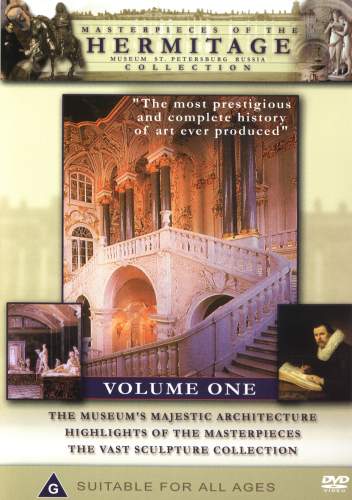Masterpieces of the Hermitage-Volume 1 (1992) |
|
Masterpieces of the Hermitage-Volume 1 (1992) |
|


|
| BUY IT |
| General | Extras | ||
| Category | Art |
Gallery-Photo Notes-History |
|
| Rating |

|
||
| Year Of Production | 1992 | ||
| Running Time | 83:12 (Case: 85) | ||
| RSDL / Flipper | No/No | Cast & Crew | |
| Start Up | Menu | ||
| Region Coding | 1,2,3,4,5,6 | Directed By | L Schwartz |
|
Studio
Distributor |
 Warner Vision |
Starring | R. Parsons |
| Case | Amaray-Transparent-Secure Clip | ||
| RPI | Box | Music |
W. A. Mozart Ludwig Van Beethoven J. S. Bach |
| Video | Audio | ||
| Pan & Scan/Full Frame | Full Frame | English Dolby Digital 2.0 (224Kb/s) | |
| Widescreen Aspect Ratio | None | ||
| 16x9 Enhancement | No | ||
| Video Format | 576i (PAL) | ||
| Original Aspect Ratio | 1.33:1 | Miscellaneous | |
| Jacket Pictures | No | ||
| Subtitles | None | Smoking | No |
| Annoying Product Placement | No | ||
| Action In or After Credits | No | ||
Undoubtedly this series has been released on DVD following the success of the film Russian Ark, which attempts to encapsulate the history of Russia and the Hermitage in one ninety-minute shot. While that series showed the museum full of characters from history, this one does not show a living soul, concentrating entirely on the works of art that form this vast collection.
The State Hermitage Museum of St Petersburg is one of the largest museums in the world, with a collection of around 3,000,000 works of art. It is housed in seven buildings constructed by Catherine the Great and her successors, starting in the mid-Eighteenth Century. Following the construction of the Winter Palace, Catherine decided she wanted a smaller, less formal building to hold balls and parties. This new building was known as the Hermitage, literally the dwelling place of a hermit, after the French fashion.
Catherine was an indefatigable collector of art, and as the art collection expanded, more buildings were added. The New Hermitage was constructed in the mid-19th Century as a public museum, and following the Bolshevik revolution of 1917, the entire complex became a centre to house the treasures of Russia.
This 16-part tour of the Hermitage's treasures was made for television in 1992. Starting with three introductory episodes, each instalment focuses on an aspect of the museum's collection. Naturally, it is impossible to cover everything, even in a series running over seven hours. The camera moves through the halls and rooms of the palaces, highlighting individual pieces in full and in close-up. The series forms a potted history of art, from ancient times to the 20th Century.
The series is narrated off-screen by R. Parsons. I have not been able to determine who this person is, but he has an at times annoying delivery. His accent is all over the place, with a mixture of a plummy English with a Welsh lilt and American-style pronunciation. I found the narration quite distracting, especially the pronunciation of certain words, like dawg for dog, lawng for long, and aduration for adoration. The script he reads effusively (written by Susan Young) is also a little banal, although it is informative about the works depicted.
Aside from the problems mentioned, the material presented is quite interesting and informative. It is a pity that this series has been given such a poor transfer.
The three episodes on this disc are:
The Museum's Majestic Architecture (29:17)
This is effectively an introduction to the series. Against the story of Catherine the Great, we are given a guided tour of the palaces that comprise the Hermitage Museum, from the construction of the Winter Palace to the addition of the New Hermitage, and how it became an art collection.
The Vast Sculpture Collection (26:55)
An overview of the collection of sculpture that the Hermitage has collected over the past 250 years, including not only the great sculptures of the Baroque, Rococo and Neo-Classical periods, but also relief works, and the museum's large collection of porcelain.
Highlights of the Masterpieces (26:59)
An overview of the vast collection of paintings amassed by the Hermitage from the time of Peter the Great onwards. Included are works from Fra Angelico to Gainsborough to Van Gogh.
When I saw the dreaded logo for Avenue One appear, I felt an impending sense of doom. And unfortunately, my fears were justified up to a point. The video quality is quite disappointing.
The video is presented in the original aspect ratio of 1.33:1, being a series made for television.
Most of the time, the video is not sharp. This has the look of being transferred from a video master. At times, it looks as if it was transferred from a VHS copy, but thankfully most of the time this is not the case. Shadow detail is not really an issue with this sort of material.
Colour is somewhat muted, but I suspect that this is due to the colour of a lot of the works of art, which have faded over the years. Bright colours appear when paintings and frescoes that include such colours are displayed, although as I am not familiar with the originals, I cannot comment on the fidelity of the image to the original.
There is some grain present, particularly in the opening and closing sequences, which are repeated from episode to episode and look different to the rest of the material, as if they were from a different source, such as stock footage. This footage also has some film artefacts, such as dirt and black flecks.
There is only one instance of aliasing present. It commences at 0:00 and goes until 83:12. Seriously. This transfer is badly affected by aliasing throughout. The museum's interior comprises a lot of intricate straight and curved lines, especially the door surrounds, the ceilings and the balustrades. So do most of the artworks. As the camera rarely remains still, the continual movement brings out aliasing in almost every shot, with some examples being at 1:39, 2:01 and 2:47. This makes a lot of the video difficult to watch. This may be less of an issue with small display devices.
There is also a problem with some of the darker works, particularly those that are dark brown. There appears to be a sort of thin gauze over the image, resulting in a scaly appearance to the image. Some of the more obvious examples are at 2:39 and 27:12.
No subtitles are provided on this single-layered disc.
| Sharpness | |
| Shadow Detail | |
| Colour | |
| Grain/Pixelization | |
| Film-To-Video Artefacts | |
| Film Artefacts | |
| Overall |
The audio would be reasonable if it were not for one significant flaw. There is a loud hum present throughout, possibly due to interference during either the recording or transfer process. It is not dissimilar to the background hum you get from a record player or turntable. This is annoying at times, although as it is continuous, the ear adjusts to a point.
There is one audio track, in English Dolby Digital 2.0.
Dialogue is generally clear and easy to understand, the narrator's foibles notwithstanding. Audio sync is not an issue.
In another glitch, the audio for the first 29 seconds on the first episode is the same as the audio for the first 29 seconds of the second episode. The narrator starts talking about the sculpture collection, but is then cut off and the correct audio is substituted.
Classical music excerpts are played in the background. The sound is a little thin and the dynamic range is that of video. Not all of the musical excerpts complement the images, but this is not a major distraction.
| Dialogue | |
| Audio Sync | |
| Clicks/Pops/Dropouts | |
| Surround Channel Use | |
| Subwoofer | |
| Overall |
10 photographs of sculptures from the collection. Of minor interest, if only to see them without aliasing.
Six pages of history relating to the construction of the Winter Palace and the acquisition of artworks by Catherine the Great, as well as her accession to the throne. The grammar is not always very good, and the information provided is not detailed, so this extra is really not worth very much.
NOTE: To view non-R4 releases, your equipment needs to be multi-zone compatible and usually also NTSC compatible.
This series has been released on a 2 disc set in Region 1. I have not been able to locate any reviews of this set to determine whether the transfer is better or the same, so at this time the best version cannot be determined.
An interesting series of programmes about the massive art collection held by the Hermitage Museum, which is spoiled by the transfer.
The video quality is very poor.
The audio quality would have been satisfactory if it was not for the omnipresent hum.
The extras are not substantial.
| Video | |
| Audio | |
| Extras | |
| Plot | |
| Overall |
| Review Equipment | |
| DVD | Pioneer DV-S733A, using Component output |
| Display | Sony 86CM Trinitron Wega KVHR36M31. Calibrated with Ultimate DVD Platinum. This display device is 16x9 capable. |
| Audio Decoder | Built in to DVD player, Dolby Digital, dts and DVD-Audio. Calibrated with Ultimate DVD Platinum. |
| Amplification | Yamaha RX-V596 for surround channels; Yamaha AX-590 as power amp for mains |
| Speakers | Main: Tannoy Revolution R3; Centre: Richter Harlequin; Rear: Pioneer S-R9; Subwoofer: JBL SUB175 |